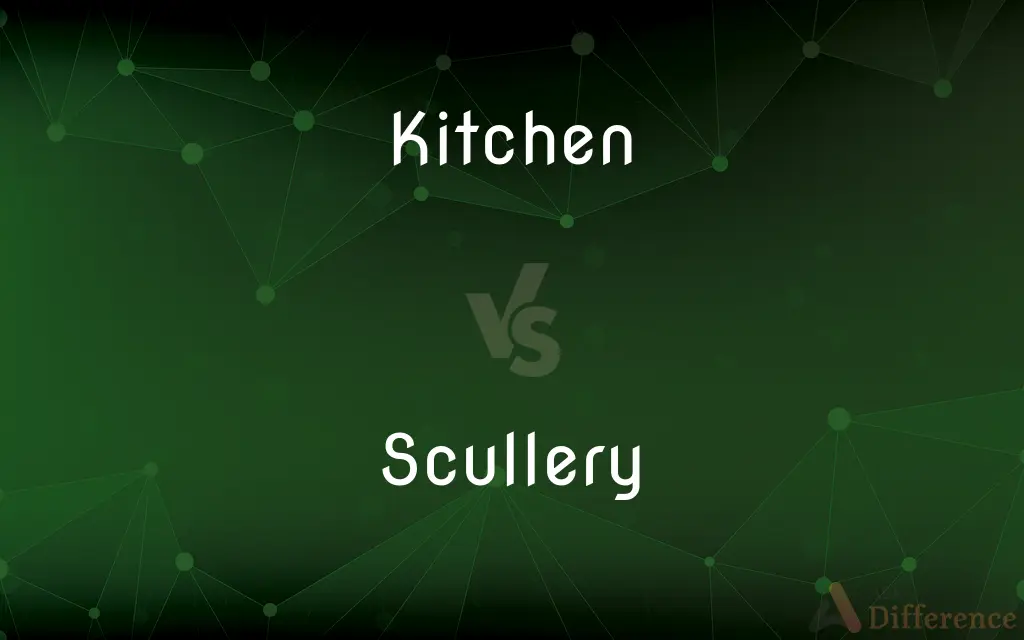Kitchen vs. Scullery — What's the Difference?
By Fiza Rafique & Maham Liaqat — Updated on April 3, 2024
A kitchen is primarily used for cooking and food preparation, while a scullery is for washing dishes and laundering clothes, often located adjacent to the kitchen.

Difference Between Kitchen and Scullery
Table of Contents
ADVERTISEMENT
Key Differences
A kitchen is the heart of a home, a space designed for cooking and food preparation, equipped with various appliances and utensils. It's a place where meals are crafted and family gatherings often occur. While a scullery, traditionally, is a smaller room or space adjacent to a kitchen, primarily used for washing dishes, cleaning fish and meat, and sometimes for laundry purposes. It serves as a utility space, keeping the mess away from the main kitchen area.
In many modern homes, the kitchen is a central hub that combines food preparation, dining, and family space into one open-plan area. It may also incorporate features such as a small seating or dining area. On the other hand, the concept of a scullery has evolved, and in contemporary houses, it may resemble a butler’s pantry or a secondary kitchen, where the main cleaning tasks are carried out away from the main kitchen to maintain its aesthetic and cleanliness.
Historically, the scullery was a staple in larger households, reflecting a time when the division of labor and spaces within a home was more pronounced. It was staffed by servants in affluent homes, underscoring the social and functional distinction between the scullery and the kitchen. Meanwhile, the kitchen was often a warmer, welcoming space, indicative of its role as a gathering spot for the family, regardless of the home's size.
The design and functionality of kitchens have evolved significantly, focusing on efficiency, aesthetics, and incorporating technological advancements. Kitchens are now designed to be ergonomic, environmentally friendly, and adaptable to the user's needs. Whereas, sculleries, when present, are designed with functionality in mind, prioritizing easy-to-clean surfaces, and ample storage for cleaning tools and supplies.
The presence of a scullery in a home today often signifies luxury or a nod to traditional home design, offering additional space for tasks that might clutter or disrupt the workflow in the main kitchen. This separation ensures that the kitchen remains a clean, inviting space for cooking and socializing, highlighting the distinct roles these two areas play in modern home design.
ADVERTISEMENT
Comparison Chart
Primary Use
Cooking and food preparation
Washing dishes and laundry
Location
Central part of the home
Adjacent to or near the kitchen
Design Focus
Ergonomics, aesthetics, and technology
Functionality and cleanliness
Historical Role
Gathering space for families, center for meal preparation
Service area for cleaning, used by servants in affluent homes
Modern Significance
Reflects home's style and user's lifestyle; incorporates dining and social spaces
Considered a luxury; keeps utility tasks separate from main kitchen space
Compare with Definitions
Kitchen
A place for culinary activities and often social gatherings.
They redesigned their kitchen to make it the heart of their home.
Scullery
A term historically associated with larger houses, indicating a designated cleaning area.
The mansion’s scullery was once bustling with servants.
Kitchen
A room or area where food is prepared and cooked.
The spacious kitchen was equipped with the latest appliances.
Scullery
An auxiliary space in homes for tasks separate from cooking, such as cleaning.
In their Victorian home, the scullery served as a vital utility area.
Kitchen
An area equipped with specific appliances for food storage, preparation, and cooking.
Their new kitchen boasted a state-of-the-art oven and a large island.
Scullery
A luxury in contemporary design, offering a hidden spot for messy tasks.
The well-designed scullery kept the main kitchen tidy during parties.
Kitchen
A symbol of home and comfort, reflecting the homeowner's style.
The rustic kitchen decor made the space feel warm and inviting.
Scullery
A small room or section of a dwelling used for washing dishes and laundry.
The scullery was located just off the kitchen, stocked with cleaning supplies.
Kitchen
A facility in a restaurant or institution where food is prepared.
The restaurant's kitchen was buzzing with activity before the dinner rush.
Scullery
In modern homes, a space akin to a butler's pantry, used for storage and cleaning.
Their modern scullery included a second dishwasher and ample shelving.
Kitchen
A kitchen is a room or part of a room used for cooking and food preparation in a dwelling or in a commercial establishment. A modern middle-class residential kitchen is typically equipped with a stove, a sink with hot and cold running water, a refrigerator, and worktops and kitchen cabinets arranged according to a modular design.
Scullery
A scullery is a room in a house, traditionally used for washing up dishes and laundering clothes, or as an overflow kitchen. Tasks performed in the scullery include cleaning dishes and cooking utensils (or storing them), occasional kitchen work, ironing, boiling water for cooking or bathing, and soaking and washing clothes.
Kitchen
A room or an area equipped for preparing and cooking food.
Scullery
A small room adjoining a kitchen, in which dishwashing and other kitchen chores are done.
Kitchen
A style of cooking; cuisine
A restaurant with a fine French kitchen.
Scullery
(historical) A small room, next to a kitchen, where washing up and other domestic chores are done.
Kitchen
A staff that prepares, cooks, and serves food.
Scullery
A place where dishes, kettles, and culinary utensils, are cleaned and kept; also, a room attached to the kitchen, where the coarse work is done; a back kitchen.
Kitchen
A room or area for preparing food.
We cook in the kitchen.
Scullery
Hence, refuse; filth; offal.
Kitchen
(by extension) Cuisine; style of cooking.
Scullery
A small room (in large old British houses) next to the kitchen; where kitchen utensils are cleaned and kept and other rough household jobs are done
Kitchen
The nape of a person's hairline, often referring to its uncombed or "nappy" look.
Kitchen
(music) The percussion section of an orchestra.
Kitchen
(dated) A utensil for roasting meat.
Kitchen
(attributive) A domesticated or uneducated form of a language.
Kitchen
(slang) A public gaming room in a casino.
Kitchen
(obsolete) Anything eaten as a relish with bread, potatoes, etc.; a condiment.
Kitchen
The region of a billiard table between the head rail and the head string.
Kitchen
To do kitchen work; to prepare food.
Kitchen
To embellish a basic food; to season, add condiments, etc.
Kitchen
(by extension) To embellish; to dress up.
Kitchen
A room equipped for cooking food; the room of a house, restaurant, or other building appropriated to cookery.
Cool was his kitchen, though his brains were hot.
A fat kitchen makes a lean will.
Kitchen
A utensil for roasting meat; as, a tin kitchen.
Kitchen
The staff that works in a kitchen.
Kitchen
To furnish food to; to entertain with the fare of the kitchen.
Kitchen
A room equipped for preparing meals
Common Curiosities
Can a modern home have both a kitchen and a scullery?
Yes, many modern homes include both, with the scullery serving as a utility space to keep the main kitchen clean and organized.
How has the function of the kitchen evolved over time?
Kitchens have evolved from purely functional spaces to central, multi-purpose areas incorporating cooking, dining, and socializing.
What is the main difference between a kitchen and a scullery?
A kitchen is for cooking and food preparation, while a scullery is focused on cleaning and sometimes laundry.
Why were sculleries more common in older, larger homes?
Older, larger homes had sculleries to separate the labor-intensive cleaning tasks from the main kitchen, often staffed by servants.
What were the traditional roles of a kitchen and scullery in a household?
Traditionally, the kitchen was the center for meal prep and family time, while the scullery was used for washing and cleaning tasks.
Is a scullery necessary in a modern kitchen design?
While not necessary, a scullery adds luxury and convenience, allowing for a dedicated space for messy tasks away from the main kitchen.
What features are typically included in a modern scullery?
Modern sculleries may include a second sink, dishwasher, storage for cleaning supplies, and sometimes additional appliances.
How does the presence of a scullery affect home design?
A scullery can enhance home design by providing a separate utility space, keeping the main kitchen area cleaner and more organized.
What is the significance of a kitchen in today's homes?
Today's kitchens serve as the heart of the home, reflecting personal style and facilitating family gatherings.
What are the benefits of having a scullery in addition to a kitchen?
Benefits include keeping the main kitchen area clean, extra storage space, and a more organized approach to household tasks.
Can a scullery add value to a home?
Yes, a well-designed scullery can add value by offering additional functional space and appealing to buyers looking for luxury features.
How can a scullery complement a modern kitchen?
A scullery complements a modern kitchen by providing a designated space for tasks that would otherwise clutter or disrupt the kitchen's flow.
How do modern kitchens integrate technology?
Modern kitchens integrate technology through smart appliances, energy-efficient designs, and ergonomic layouts.
Share Your Discovery

Previous Comparison
Circle vs. Sphere
Next Comparison
Referee vs. ReferralAuthor Spotlight
Written by
Fiza RafiqueFiza Rafique is a skilled content writer at AskDifference.com, where she meticulously refines and enhances written pieces. Drawing from her vast editorial expertise, Fiza ensures clarity, accuracy, and precision in every article. Passionate about language, she continually seeks to elevate the quality of content for readers worldwide.
Co-written by
Maham Liaqat













































